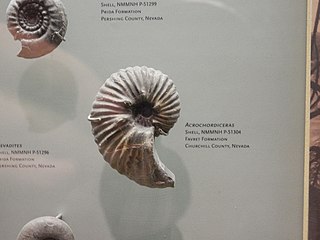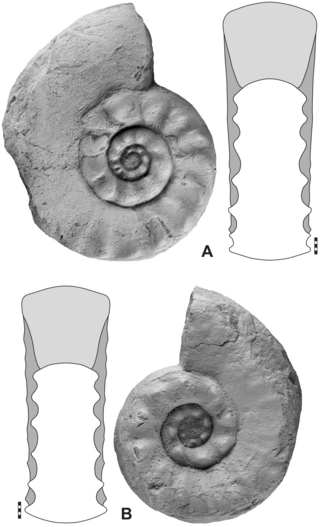
Acrochordiceras is a genus of Middle Triassic ammonoid cephalopods belonging to the ceratitid family Acrochordiceratidae, included in the superfamily Ceratitoidea.

Alsatites is an extinct genus of cephalopod belonging to the Ammonite subclass. They lived during the Early Jurassic, Hettangian till the Sinemurian and are generally extremely evolute, many whorled. Keel broad and blunt organisms, they also exhibit a primary ribbing which is close and persistent.

Audaxlytoceras is an extinct genus of lytoceratid ammonites.
Anderssonoceras is a genus of small, smooth ammonites with a flared umbilical shoulder, like Prototoceras, assigned to the ceratitid family Anderssonoceratidae as the type, but once included in the Otoceratidae.
Anotoceras is a genus of smooth shelled, discoidal ammonites with a depressed, subtrigonal whorl section and ceratitic sutures included in the ceratitid family Otoceratidae.
Arctogymnites is a genus of ammonoid cephalopods from the middle Triassic included in the ceratitid subfamily Beyrichitinae. Related genera include Beyrichites, Frechites, Gymnotoceras, and Salterites
Dobrogeites is a genus of ammonoids from the order Ceratitida, included in the family Megaphyllitidae that produced evolute compressed planispiral shells with rounded venters, inner whorls ornamented as in Tirolites, outer whorls smooth, suture with multiple smooth lobes; Initially found in Anisian sediments in Romania.
Ussurites is an extinct ammonoid cephalopod genus belonging to the suborder Phylloceratina and is included in the family Ussuritidae. Its range is restricted to the early Middle Triassic, (Anisian)
Lecanites is a ceratitid genus assigned to the Danubitaceae, with an essentially smooth, evolute, discoidal shell and a goniatitic suture with many elements. It is the type and now only genus of the Lecanitidae.
The Danubitoidea is a large and diverse superfamily in the order Ceratitida of the Ammonoidea that combines five families removed from the Ceratitaceae, Clydonitaceae, and Ptychitaceae.
Longobarditidae is a family of ceratitd ammonoids known from the early Triassic, included in the Danubitaceae. Longobarditidae includes genera formerly placed in Hungaritidae by the American Treatise on Invertebrate Paleontology, Part L, 1957 as well as genera that have been described since.
Ptychitoidea, formerly Ptychitacheae, is a superfamily of typically involute, subglobular to discoidal Ceratitida in which the shell is smooth with lateral folds or striations, inner whorls are globose, and the suture is commonly ammonitic. Their range is Middle_ and Upper Triassic.
Pinacoceratoidea, formerly Pinacocerataceae, are generally smooth, compressed, evolute to involute ammonoids from the Triassic, belonging to the Ceratitida, in which the suture is ammonitic, with adventitious and auxiliary elements.
Clionitidae is a family of generally evolute, Upper Triassic, ammonoids with a ventral furrow usually bordered by rows of tubercles and whorl sides ornamented by sigmoidal ribs which may bear spiral rows of tubercles. The suture is ceratitic.
Californites is a genus of the Upper Triassic clydonicoidean family Clionitidae with a discoidal, evolute shell and radial tuberculate ribs that end in strong ventrolateral spines. The whorl section is described as trapezoidal. The venter is low-arched, smooth, and has a strong but narrow median groove.

Paratirolites is a genus of Early Triassic ceratites from Armenia and Iran with distinct ribs, prominent ventro-lateral tubercles, and a broadly arched venter. The suture is ceratitic with a large ventral saddle. Ceratites are ammonoid cephalopods that lived during the Late Permian and Triassic.

Gymnites is a genus of ammonoid cephalopod from the Middle Triassic belonging to the ceratitid family Gymnitidae. These nektonic carnivores lived during the Triassic period, Anisian age.

Gymnitidae is a family of Lower to Middle Triassic ammonite cephalopods with evolute, discoidal shells.

Ophiceras is a genus of smooth, evolute ceratitid ammonites from the Early Triassic, with a rounded venter. Fossils of the genus have been found in Armenia, Azerbaijan, China, Greenland, and India.

Catenohalorites is an extinct genus of Triassic ammonoids belonging to the family Haloritidae.







